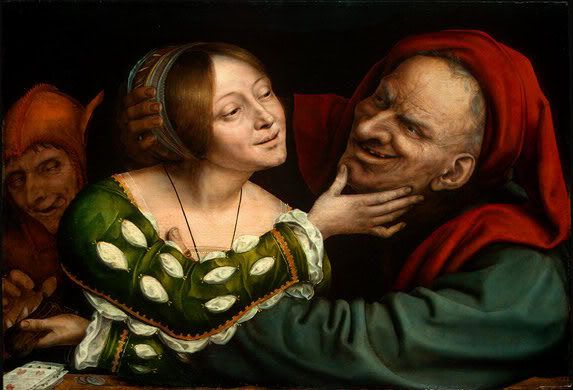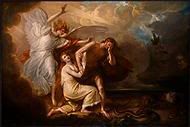These selections of paintings highlight the daily life of the Dutch in the 1600’s. These paintings are a collection of works by the Dutch master’s Paulus Potter (1625-1654), Gerard ter Borch II (1617-1681), Pieter de Hooch, Gabriel Metsu, Jan Steen (1625/1626-1679), and Adriaen van Ostade (1610-1685) The iconic masterpieces on view are Potter’s "A Farrier’s Shop", an oil on panel (1648), Borch’s "The Suitors Visit", a oil on canvas (1658), Hooch’s "A Dutch Courtyard", an oil on canvas
(1658/1660), Metsu’s "The Intruder", an oil on panel (1660), Steen’s "The Dancing Couple", an oil on canvas (1663), and Ostade’s "The Cottage Dooryard", an oil on canvas (1673). The artist’s in this exhibition use both visual elements and principles of design to capture not the people in the painting, but what they are doing.
Potter uses value and implied light in his painting. Value refers to the relative lightness or darkness (92). The shop is painted in dark hues while the outdoors of the painting is painted in light hues. Implied light is the use of value to create the allusion of light in two dimensional art works (91-92). The light is casting down from the upper left of the painting. The shadows of the animals, house, and humans make the painting more realistic. Another Dutch painter employed similar techniques.
Borch used subordination, implied lighting, and color in his painting. Subordination means that certain areas of the composition are purposefully made less visually interesting, so that the areas of emphasis stand out (134). The characters in the background are blurred which emphasizes the two characters in the foreground. The implied lighting is coming from the left, possibly from the open door or a window. The shadows of the characters can be seen on the floor and back walls. Borch uses complimentary harmonies in this painting. Complimentary harmonies involve colors directly opposite one another on the color wheel (97). The woman in the center is dressed in the warm color orange in contrast with the other woman dressed in a cool hue of blue. This contrast guides the viewer too see the main character as well as the other couple in the room. The similarities continue on with our next artist.
In Hooch’s painting he depicts a scene of tranquility and relaxation. The artist emphasizes the geometry of the bricks, walls, and windows. Similar to Borch, Hooch employs complimentary harmonies. The artist uses warm colors against cool colors. He emphasizes points in the painting with the warm hues of Orange in contrast with the blue sky. He uses the color orange in the woman dress, on the brick, and shutters on the windows. Our next painting also uses similar techniques discussed.
Metsu’s depiction of a young man visiting his betrothed is often compared with Borch’s "The Suitors Visit". Similarly Metsu’s also employs subordination, emphasis, and implied lighting in his painting. Emphasis is when the viewer’s attention is drawn more to certain parts of a composition than to others (134). Like Borch’s painting, a man is visiting a woman. Notice the woman, most likely her mother, is sitting near the window. Her face is painted so dark the viewer can vaguely see her smiling. Although this is important to this piece, the artist paints the background blurry and darker in contrast to the woman in the center. Metsu uses color to emphasize the woman in the center. In contrast to the dark surroundings and other characters, she is dressed in light and warm colors. Implied light is caused by the light coming through the window. The lighting puts an emphasis on the woman standing in the center. This effect makes the woman the focal point of the painting. Although our next painter is also Dutch, he uses different techniques than the previous painters.
In contrast to the previous paintings discussed, Steen doesn’t employ deeply contrasting colors or values. The colors are mostly cool shades of blue and green. Steen doesn’t use subordination like the other artists. He does use directional lines to bring the viewers eyes to the couple. The people sitting in the lower right hand corner are facing the couple dancing, the guitarist’s body is turned towards them, and on the left side the mother is holding her little girl as she looks at the dancers. Similarly the painting is of a gathering of a community. Thus far the paintings of the Dutch have been warm and inviting scenes. Our next painter creates a scene that deeply contrasts to previous paintings.
Oastade’s painting depicts the Dutch’s poor. Like Hooch, Ostade used the geometry of his buildings and landscape to emphasize the painting. Unlike the even and clean bricks of Hooch’s landscape, Oastade emphasizes the dirt yard and cluttered surroundings. The color red is used around the painting to attract the viewer’s attention. The arrangement of the clothing line and woman working depicts a less harmonious and merry surrounding than Hooch’s "A Dutch’s Courtyard".
A last note on similarities, notice each painting used the warm shades of red and orange! Many of the Artists in this exhibition trained and painted with one another. It is easy to see the similarities in these masterpieces, as well as their unique differences. These Artists used their skill and the principles in creating wonderful paintings that represent the everyday life and trials of the Dutch in the 1600’s.
Sources:
Getlein, Mark. Living With Art. 8th Edition. McGraw-Hill. 2008
National Gallery of Art. HTTP://WWW.NGA.GOV














